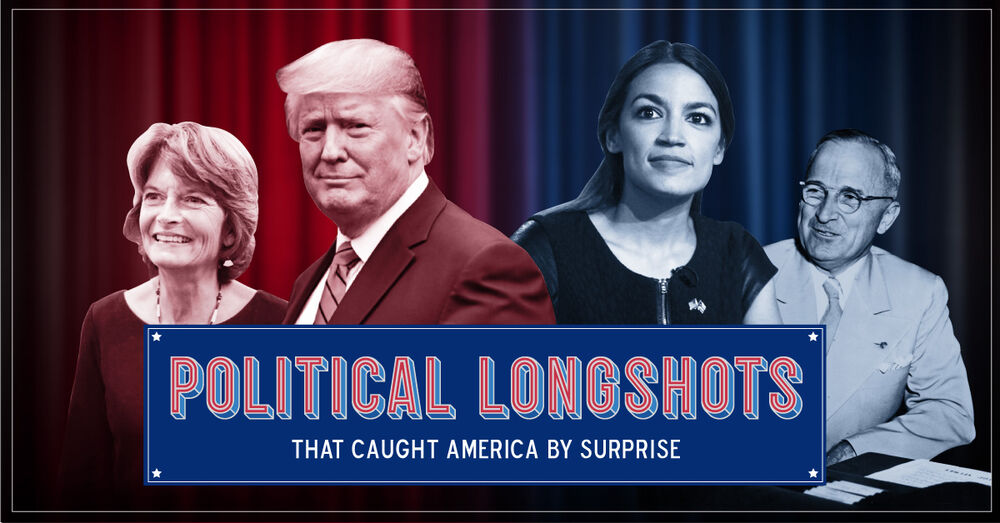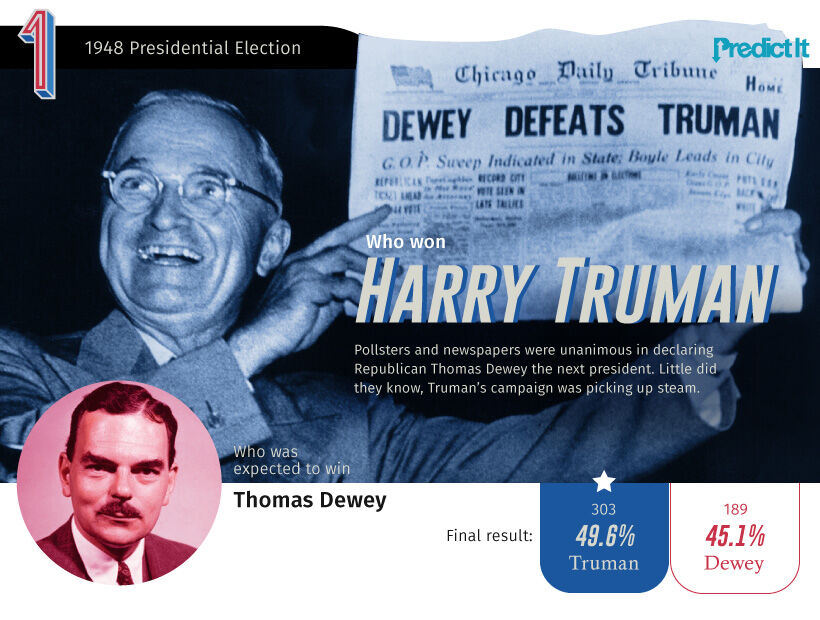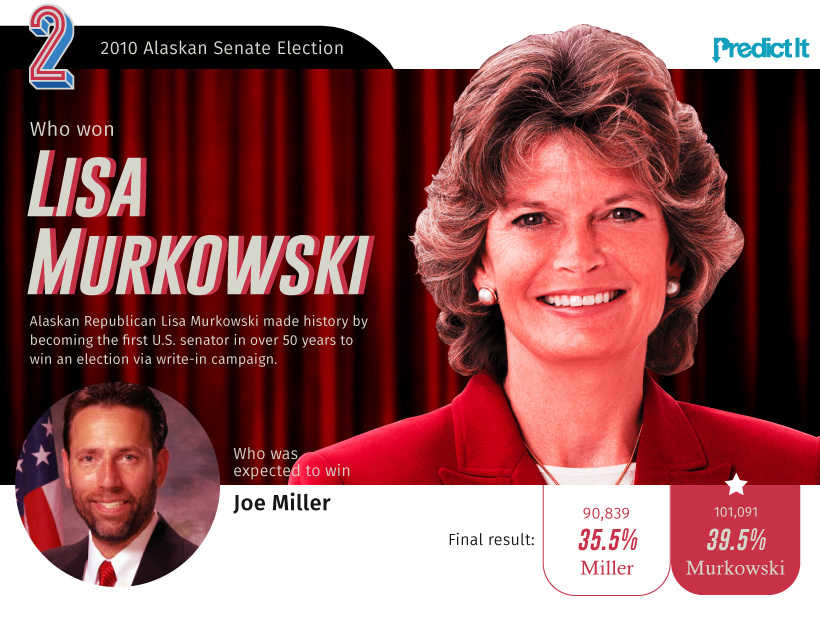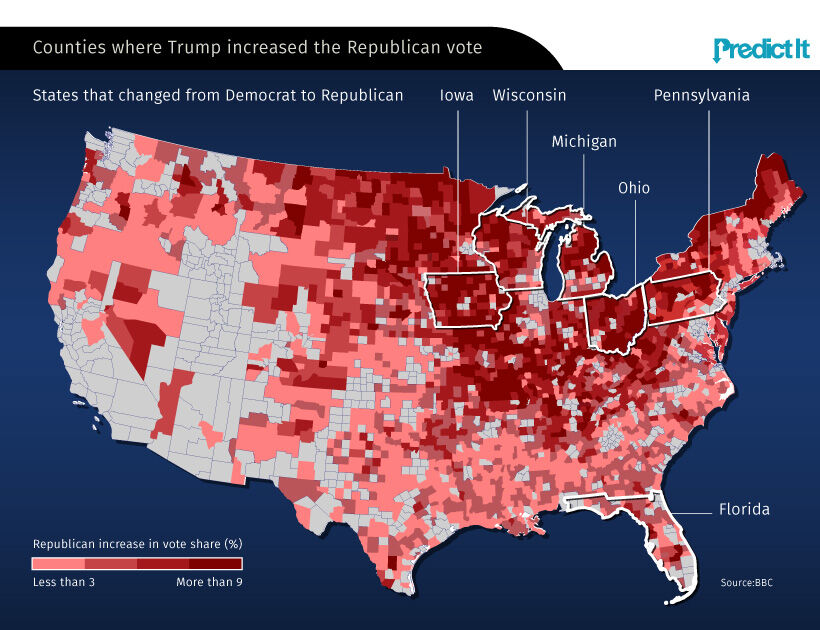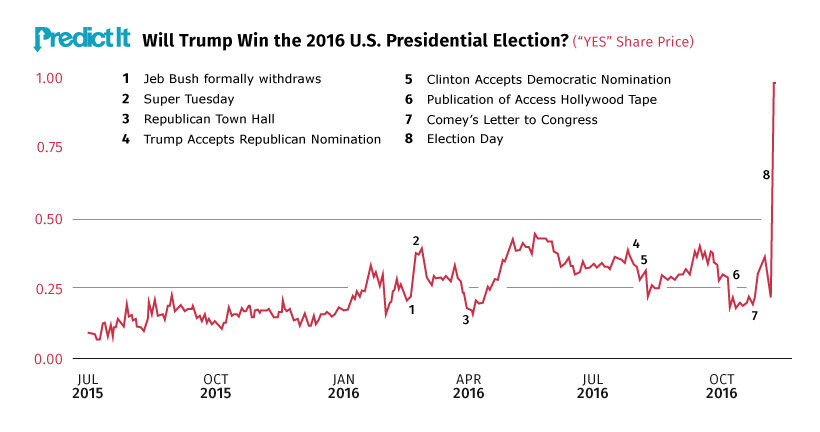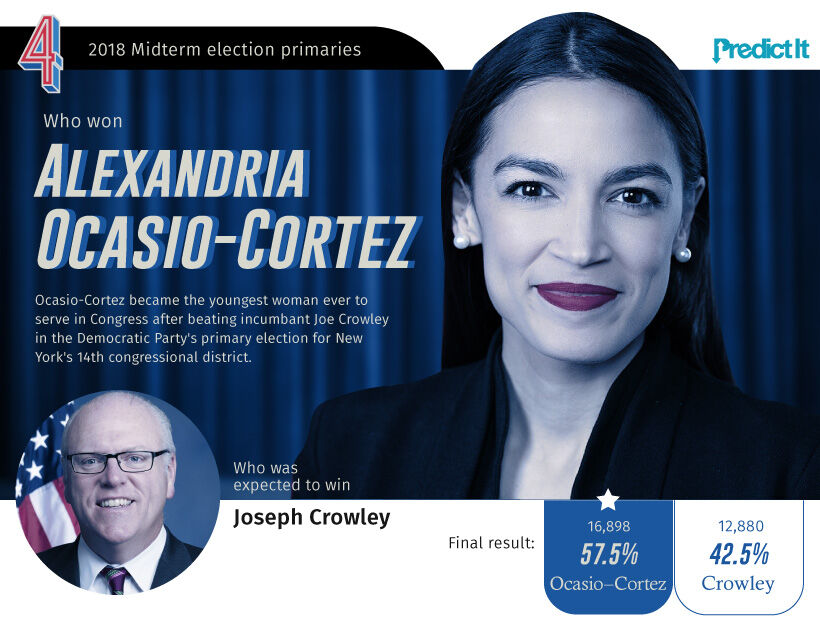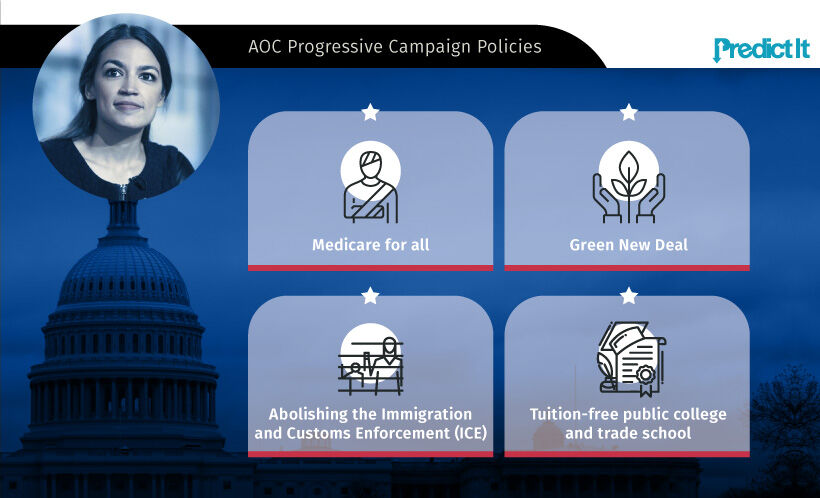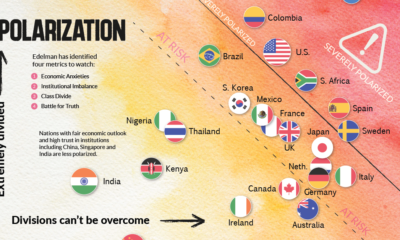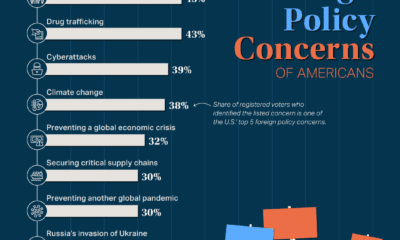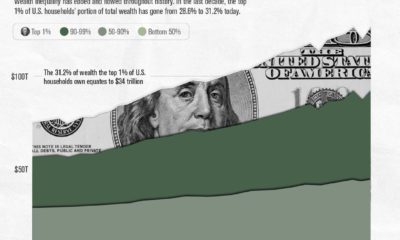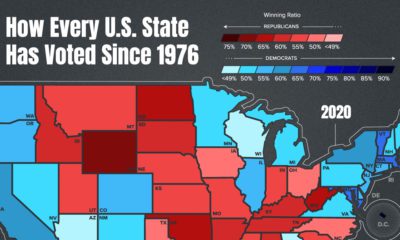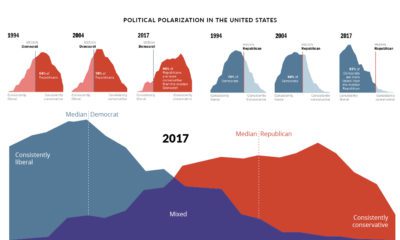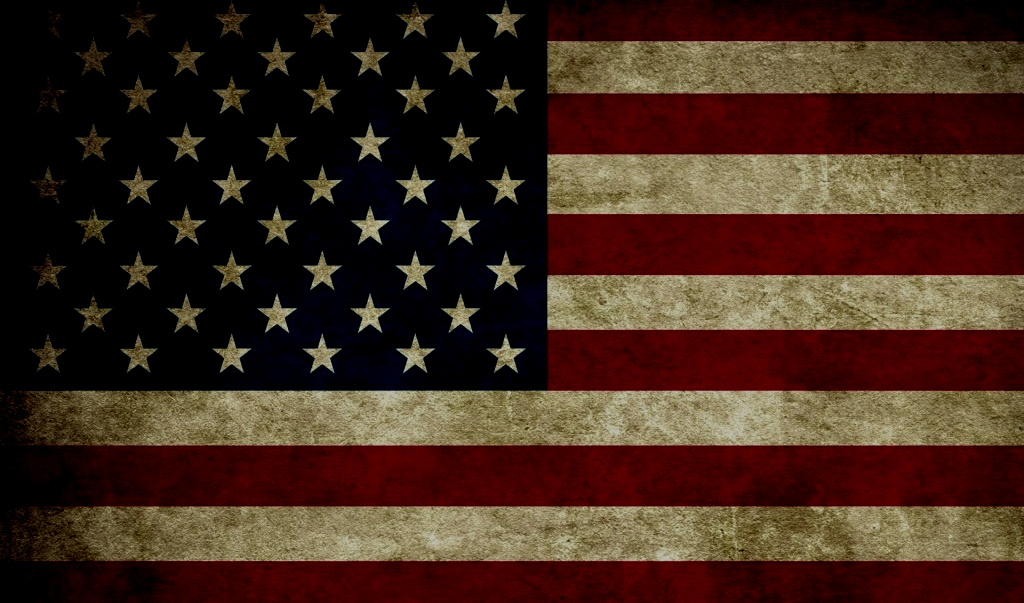Millions of Americans rely on polls and the media to gauge the direction of political elections. Politics are sometimes unpredictable though, and on occasion, election outcomes can defy conventional wisdom. These surprises, known as political longshots, are scattered throughout American political history. As time winds down to the 59th U.S. presidential election in November, today’s visual article from PredictIt goes back in time to showcase moments when polls, media outlets, and the American public were left stunned.
The Truman Show
What Happened?
As elections approached in 1948, incumbent Harry Truman led a struggling Democratic party. Not only had they lost control of both chambers of Congress two years prior, they also faced internal divide over Truman’s civil rights initiatives. To make matters worse, Truman’s approval rating in June 1948 sat at just 39%. Pollsters and the media were unanimous in declaring Republican Thomas Dewey the next president, but this didn’t discourage Truman from running a tactical campaign which featured: Despite being overlooked by many, Truman went on to claim a decisive victory. This caused one of the most famous media blunders in U.S. history—with high confidence in the polls, editors at the Chicago Daily Tribune prematurely reported Dewey as the winner of the election. —George Gallup Jr. Pollsters took a hit to their credibility, but used the opportunity to refine their methods. They extended the deadlines of polls and, over time, began using a methodology known as random sampling. This replaced quota sampling, a methodology prone to bias because it questioned a predetermined number of people from certain ethnic and age groups.
Murkowski’s Comeback
What Happened?
After losing the Republican primary to Joe Miller, incumbent senator Lisa Murkowski decided to run in 2010 as a write-in candidate. A somewhat unique aspect of American politics, a write-in candidate is one whose name does not appear on the ballot, and instead needs to be written in by the voter directly. Miller, the Republican nominee, was supported by the Tea Party movement and former Alaskan governor Sarah Palin. All momentum seemed to be in his favor, according to polls conducted roughly a month ahead of election day: Source: Rasmussen Reports, Moore Research, CNN/Time/Opinion Research Despite Miller’s lead in the polls, Murkowski’s write-in campaign was able to capitalize on the state’s significant number of independent voters. On election day, Murkowski collected 101,091 write-in votes—a comfortable margin above Miller’s 90,839 votes. —Lisa Murkowski Miller challenged 8,000 write-in votes on the basis of name misspellings, but his claims were rejected by the Alaska Superior Court—perfect spelling on write-in ballots is not required if the voter’s intent is clear.
The Trump Train
What Happened?
Donald Trump’s 2016 victory will likely top the list as one of the most shocking political events of our time. As election day approached, many of America’s mainstream media outlets pointed to a decisive Clinton victory. Source: The Wrap, CNN While Trump’s rhetoric was largely opposed in urban regions (which often lean Democrat), the media failed to recognize that his message was resonating in America’s industrial Midwest. One potential explanation for this is that the region’s manufacturing jobs had been drying up, causing workers to feel abandoned by the existing political establishment. This led to a number of Democrat-controlled states flipping Republican, and was a critical force for propelling Trump to the White House.
In PredictIt’s market, Will Trump Win the 2016 Presidential Election, traders also underestimated Trump’s chances of winning. Throughout the entire campaign phase, Trump’s “yes” shares failed to break past the 50 cents marker.
Source: Predictit Share prices climbed 64% after FBI Director James Comey released his letter regarding the Clinton email investigation, but these gains were erased in the days leading up to elections. It wasn’t until November 8th, election day, that the prediction market swung by an incredible 345% in favor of Trump.
The Rise of AOC
What Happened?
The biggest surprise from the 2018 midterm primaries was Alexandria Ocasio-Cortez’s (AOC) victory over incumbent Joseph Crowley in New York’s 14th Congressional District. That’s because the two candidates were nearly complete opposites of one another: Source: abc news AOC led a grassroots campaign appealing to the district’s ethnically diverse population, which many believed Crowley could not relate with. Her platform included:
Also lending to the surprise factor was AOC’s relatively sparse media coverage. Because her campaign was largely operated through social media platforms such as Twitter and Instagram, it flew under the radar of traditional political media coverage. —Dave Weigel, Washington Post AOC would go on to win New York’s 14th Congressional District in the 2018 midterm election, defeating Republican Anthony Pappas with 110,318 votes to 19,202, to become the youngest woman to ever serve in the U.S. Congress. More recently, she secured her re-election in the 2020 Democratic primaries. This time, however, it comes as less of a surprise.
What’s Next?
The very definition of a longshot means that they are difficult to quantify and predict. However, one potential longshot in the making may be 21-time Grammy Award winner Kanye West, who announced his intention to run for president on July 4th. While he hasn’t taken any official steps towards running as an independent candidate, he has garnered the support of notable figures like Tesla CEO Elon Musk. West first declared his interest in the presidency during an acceptance speech at the 2015 MTV Video Music Awards. Looking further down the road, Democratic presidential nominee Joe Biden has still not declared his running mate. Much is at stake for Democrats hoping to deny Trump a second term, and the VP nominee will likely play a significant role in how the party performs. Biden has a long list of candidates that, for the first time in history, predominantly features women of color. Speculation is ramping up as the 2020 presidential elections approach. While it’s difficult to say when politics will surprise us again, more longshots are sure to be in store. on Even while political regimes across these countries have changed over time, they’ve largely followed a few different types of governance. Today, every country can ultimately be classified into just nine broad forms of government systems. This map by Truman Du uses information from Wikipedia to map the government systems that rule the world today.
Countries By Type of Government
It’s important to note that this map charts government systems according to each country’s legal framework. Many countries have constitutions stating their de jure or legally recognized system of government, but their de facto or realized form of governance may be quite different. Here is a list of the stated government system of UN member states and observers as of January 2023: Let’s take a closer look at some of these systems.
Monarchies
Brought back into the spotlight after the death of Queen Elizabeth II of England in September 2022, this form of government has a single ruler. They carry titles from king and queen to sultan or emperor, and their government systems can be further divided into three modern types: constitutional, semi-constitutional, and absolute. A constitutional monarchy sees the monarch act as head of state within the parameters of a constitution, giving them little to no real power. For example, King Charles III is the head of 15 Commonwealth nations including Canada and Australia. However, each has their own head of government. On the other hand, a semi-constitutional monarchy lets the monarch or ruling royal family retain substantial political powers, as is the case in Jordan and Morocco. However, their monarchs still rule the country according to a democratic constitution and in concert with other institutions. Finally, an absolute monarchy is most like the monarchies of old, where the ruler has full power over governance, with modern examples including Saudi Arabia and Vatican City.
Republics
Unlike monarchies, the people hold the power in a republic government system, directly electing representatives to form government. Again, there are multiple types of modern republic governments: presidential, semi-presidential, and parliamentary. The presidential republic could be considered a direct progression from monarchies. This system has a strong and independent chief executive with extensive powers when it comes to domestic affairs and foreign policy. An example of this is the United States, where the President is both the head of state and the head of government. In a semi-presidential republic, the president is the head of state and has some executive powers that are independent of the legislature. However, the prime minister (or chancellor or equivalent title) is the head of government, responsible to the legislature along with the cabinet. Russia is a classic example of this type of government. The last type of republic system is parliamentary. In this system, the president is a figurehead, while the head of government holds real power and is validated by and accountable to the parliament. This type of system can be seen in Germany, Italy, and India and is akin to constitutional monarchies. It’s also important to point out that some parliamentary republic systems operate slightly differently. For example in South Africa, the president is both the head of state and government, but is elected directly by the legislature. This leaves them (and their ministries) potentially subject to parliamentary confidence.
One-Party State
Many of the systems above involve multiple political parties vying to rule and govern their respective countries. In a one-party state, also called a single-party state or single-party system, only one political party has the right to form government. All other political parties are either outlawed or only allowed limited participation in elections. In this system, a country’s head of state and head of government can be executive or ceremonial but political power is constitutionally linked to a single political movement. China is the most well-known example of this government system, with the General Secretary of the Communist Party of China ruling as the de facto leader since 1989.
Provisional
The final form of government is a provisional government formed as an interim or transitional government. In this system, an emergency governmental body is created to manage political transitions after the collapse of a government, or when a new state is formed. Often these evolve into fully constitutionalized systems, but sometimes they hold power for longer than expected. Some examples of countries that are considered provisional include Libya, Burkina Faso, and Chad.
